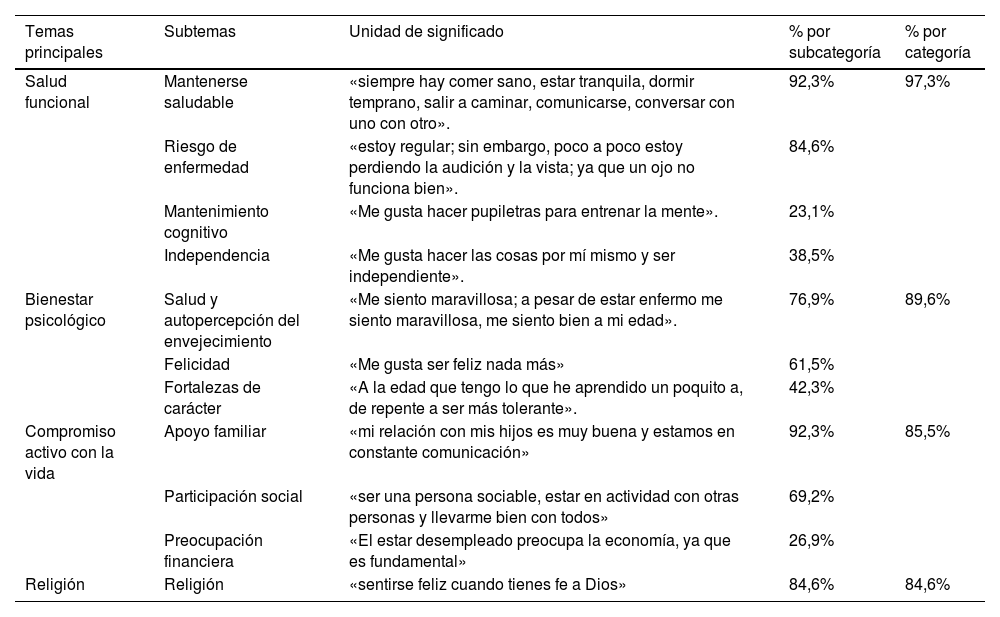La comprensión de los dominios del envejecimiento saludable (ES) a través de las percepciones de las personas adultas mayores (PAM), son importantes para la determinación multidimensional del constructo según la cultura de Perú y para el desarrollo de planes que promuevan la salud, el bienestar, los recursos y las fortalezas de las PAM. El propósito de este estudio es explorar cualitativamente los dominios operativos del ES en adultos mayores peruanos.
MétodoEl enfoque adoptado es descriptivo, cualitativo y fundamental. Se usó un muestreo intencional y se reclutaron a 26 participantes que asisten a centros del adulto mayor pertenecientes a la comuna municipal de Lima (media de edad=67,9; desviación estándar [DE]=6,64). Se realizaron entrevistas semiestructuradas y el análisis de contenido se hizo mediante un método inductivo identificando las unidades de significado del ES.
ResultadosEl análisis de contenido muestra 11 subtemas y cuatro temas principales. Los temas identificados fueron los siguientes: «salud funcional», «bienestar psicológico», «compromiso activo con la vida» y «religión». Ante ello, los resultados demuestran la multidimensionalidad del ES en los adultos mayores peruanos.
ConclusiónLos dominios operativos del ES indican la importancia de las percepciones individuales considerando la salud funcional, bienestar psicológico, compromiso activo con la vida y la religión. Esta perspectiva apoya el concepto multidimensional del ES. Esto puede implementarse como una guía para las entidades gubernamentales que trabajen con las PAM; además, de formular nuevas políticas públicas centrándose en los dominios del ES.
Understanding the domains of healthy aging (HA) through the perceptions of older adults is important for the multidimensional determination of the construct according to the culture of Peru and for the development of plans that promote the health, well-being, resources and strengths of older adults. The purpose of this study is to qualitatively explore the operational domains of HA in Peruvian older adults.
MethodThe approach adopted was fundamental qualitative descriptive. A purposive sampling was used and 26 participants attending senior centers belonging to the municipal commune of Lima were recruited (Medad=67.9; SD=6.64). Semi-structured interviews were conducted and the content analysis was carried out using an inductive method identifying the units of meaning of the HA.
ResultsThe content analysis showed 11 sub-themes and 4 main themes. The identified themes were as follows: “functional health”, “psychological well-being”, “active engagement with life” and “religion”. Given this, the results demonstrate the multidimensionality of HA in Peruvian older adults.
ConclusionThe operational domains of HA indicate the importance of individual perceptions considering functional health, psychological well-being, active engagement with life, and religion. This perspective supports the multidimensional concept of HA. This can be implemented as a guide for government entities working with PAMs. In addition, to formulate new public policies focusing on the domains of HA.
Artículo
Comprando el artículo el PDF del mismo podrá ser descargado
Precio 19,34 €
Comprar ahora







